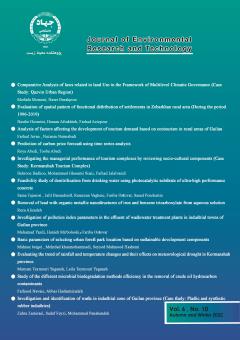Prediction of carbon price forecast using time series analysis
Subject Areas : environmental economy
1 - عضو هیئت علمی
Keywords: Carbon, Climate change, Price, Kyoto Protocol,
Abstract :
Many economic tools have been proposed and used to reduce climate change. Carbon trading is one of these market-based tools that is recognized as a cost-effective way to change climate and environmental issues. Today, the issue of carbon sequestration and bioenergy production versus fossil fuels is great concern of governments, and many efforts have been made to reduce or control carbon dioxide emissions. The aim of this study is to investigate carbon price fluctuations and predict price trends based on historical carbon price data in the time series 2005-2020. Data were analyzed by regression analysis based on Fuller augmented Dicky after eliminating inflation. The results show that the trend of carbon prices has fluctuated during this period. The average expected price of carbon is 3,303,589 Iranian Rials.Many economic tools have been proposed and used to reduce climate change. Carbon trading is one of these market-based tools that is recognized as a cost-effective way to change climate and environmental issues. Today, the issue of carbon sequestration and bioenergy production versus fossil fuels is great concern of governments, and many efforts have been made to reduce or control carbon dioxide emissions. The aim of this study is to investigate carbon price fluctuations and predict price trends based on historical carbon price data in the time series 2005-2020. Data were analyzed by regression analysis based on Fuller augmented Dicky after eliminating inflation. the trend of carbon prices has ش fluctuated during this period. The average expected price of carbon is 3,303,589 Iranian Rials.
1. بانک مرکزی جمهوری اسلامی ایران، (1397)، «شاخص بهای کالا و خدمات مصرفی در مناطق شهری ایران» (www.cbi.ir).#
2. حاتمی، نیشتمان. محمدی لیمائی، سلیمان. معیری، محمدهادی. 1397. پیش بینی و بررسی قیمت چوب سرپای برخی ازگونه های جنگل های خزری. نشريه پژوهش هاي علوم و فناوري چوب و جنگل. 69-51 (25): 4. #
3. سعید، محسن. رعایانی، عماد، (1392)، «جایگاه ایران در مدیریت کربن در مقایسه با کشورهای منطقه خاورمیانه و شمال آفریقا و ارزیابی پتانسیل های موجود برای ازدیاد برداشت و ذخیره سازی CO2»، نشریه اکتشاف و تولید نفت و گاز، شماره 107، صفحه 31-26.#
4. طوبی عابدی، سلیمان محمدی لیمائی، امیراسلام بنیاد، جواد ترکمن. 1399. تعیین سن بهینه بهره¬برداری جنگل¬کاری صنوبر (Populus deltoides) با توجه به ارزش ترسیب کربن. بومشناسی جنگلهاي ایران. 31-22 :(8) 15. #
5. محمدی، حسین. عباسی، فایزه. کاربخش راوری، سمیه، (1395)، «ارزیابی پیامدهای اقتصادی-محیط زیستی گرمایش جهانی بر دستاوردهای اجرای پروتکل کیوتو در جمهوری اسلامی ایران»، پژوهش های محیط زیست، سال 7، شماره 14، صفحه 32-17. #
6. محمدی، زهره. محمدی لیمائی، سلیمان. 1393. پیشبینی قیمت چوب گونههای جنگلی در استان گیلان با استفاده از تجزیه وتحلیل سریهای زمانی. نشریه توسعه پایدار جنگل،308-297: (9) 4. #
7. ورامش، سعید. حسینی، سید محسن. عبدی، نوراله، (1390)، «برآورد نيروي جنگل شهري در ترسيب كربن اتمسفري»، محیط شناسی، سال 37، شماره 57، صفحه 120-113. #
8. Adetoye A. M., Okojie, L. O., Akerele, D., )2018(, “Forest carbon sequestration supply function for African countries: An econometric modelling approach”, Forest Policy and Economics 90: 59–66.#
9. Asante P., Armstrong Glen W., Adamowicz Wiktor L. (2011), “Carbon sequestration and the optimal forest harvest decision: A dynamic programming approach considering biomass and dead organic matter”, Journal of Forest Economics, 17(1): 3–17.#
10. Assmuth, A., Tahvonen, O. (2018), “Optimal carbon storage in even- and uneven-aged forestry”. Forest Policy and Economics, 87: 93–100.#
11. Carbon Emissions Futures Historical Prices, (2017), Available at https://www.investing.com/commodities/carbon-emissions-historical-data.#
12. Ekholm, T., (2016), “Optimal forest rotation age under efficient climate change mitigation”. Forest Policy and Economics 62: 62–68.
13. Liu, W. Y., Lin, C. C. & Su, K. H., (2017), “Modelling the spatial forest-thinning planning problem considering carbon sequestration and emissions”, Forest Policy Economics 78, 51–66.#
14. Mohammadi Limaei, S., (2011), “Economics optimization of forest management”, Lap Lambert Academic Publication, Germany, 140p.
15. Olschewski, R., Benítez, P.C., (2010), “Optimizing joint production of timber and carbon sequestration of afforestation projects”, Journal of Forest Economics. 16 (1):1–10.#
16. Robertson, K., Loza-Babuena, I., Ford-Robertson, J., (2004), “Monitoring and economic factors affecting the economic viability of afforestation for carbon sequestration projects”, Environmental Science and Policy. 7: 465-475. #
17. Zhou M., (2015), “Adapting sustainable forest management to climate policy uncertainty: A conceptual framework”, Forest Policy and Economics 59: 66–74.#


